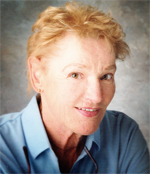Vic Seixas:
Full Life, Happy Man
Lee Tyler
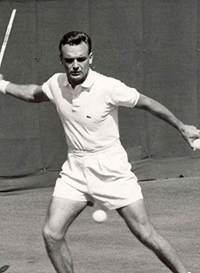
Seixas rhymes with gracious. And Vic Seixas is gracious.
The other day, at The Club at Harbor Point, Mill Valley, California, a few miles over the Golden Gate Bridge from San Francisco, I had the pleasure of chatting with E. Victor Seixas, Jr., American tennis champion. (The E. stands for Elias.)
Now 90, Vic is third oldest of the living male in the International Tennis Hall of Fame. (Gardnar Mulloy tops the list at 100. Pancho Segura is second at 92).
For those of you who might be unaware, Vic won the singles title at Wimbledon in 1953, was a finalist at the French that same year and won the US title a year later in 1954. He won 5 Grand Slam titles in doubles, four of those with Tony Trabert.
Trim, white-haired, nearly as handsome as in his heyday, but possibly slightly slower, Vic hasn't touched a racket in 20 years. "But I love talking tennis," he smiles.
His story is a window into the glory days of amateur tennis. Today players begin single minded preparation for the tour in their teens. They chase big money and tennis is literally their lives.
How different in Vic's day! For elite players, including many players like Vic who won multiple Grand Slam titles, that option did not exist. There was no money for winning at the highest levels.
Vic's story is a different path. It shows how a great player balanced amateur tennis with education, military service, a business career, and family life. Judge for yourself which option seems more fulfilling.
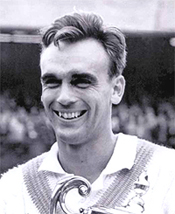
Early Life
Seixas was an only child, born in1923 and raised in a suburb of Philadelphia. His ties with tennis began at age 6, chasing errant balls that his dad ("a very mediocre player") and his dad's friends hit over the fence at their neighborhood club. At age 8, Vic had his first and only tennis lesson. "All I was shown was how to hold the racket". At 10 he entered his first tournament -- a mens' event--and defeated a 20-year-old in the first round.
"I can still remember his name - Sam Pruitt. He was so mad being beaten by a kid he swore off tennis for the rest of his life." From then on, Vic was hooked on competition, and entered every boys 'and junior tournament he could find.
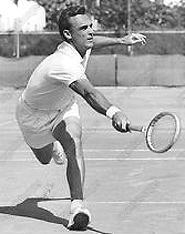
At 16, in 1939, Vic was also a senior ballboy at the last Davis Cup Challenge Round played before World War II. It was Australia vs. United States at the Merion Cricket Club, and in Vic's words,"a thriller."
Joe Hunt and Jack Kramer (who was 18 and just 2 years older Seixas) lost the doubles to John Bromwich and Adrian Quist, and the Cup went down under. It was 7 years before America won it again in1946.
Watching the best players in the world, Vic learned something. "I noticed that Parker and Bromwich never came to the net, and made a note to myself not to make that mistake."
A year later, Vic made the Junior Davis Cup Team, and sent to compete in his first National Singles at Forest Hills. The next year, in the summer of 1941, he won his first national titles -- the Interscholastic Singles, and also the doubles with boyhood friend Bill Vogt.
Then came World War II. Vic was in his first month as a freshman at the University of North Carolina and enlisted in the air force.
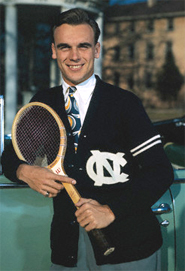
"I'd never been near a plane but had taken a lot of math in school and thought I might make it as navigator." Instead he beame a flight instructor and a test pilot.
His only competitive tennis event during the war was in 1944 when he was given a leave to play the National Singles. He only had one racket - the one issued me by the Junior Davis Cup team. When it broke he had to borrow a racket from another player, a Wilson Don Budge autograph.
"I stayed faithful to the Wilson Budge, and never played with anything else until the metal frames came along."
On New Year's Eve of 1944, Seixas and 200 other flight instructors shipped out to the Pacific. It took 10 seasick days to reach New Guinea.
There they put planes together that had been shipped in parts, and air-tested them. "I flew everything there was," Seixas said.
Vic was then sent to Japan for the first 9 months of the occupation. "Everything was rubble except the emperor's palace and the hotel where MacArthur had his headquarters. "We wondered if there'd be hostility but the people were quite friendly once they saw we weren't going to be monsters."
Discharged with the rank of 1st Lieutenant, he was sent home to Pennslyvania in the spring of 1946. "My first thought was to get back to tennis. I entered a big annual tournament at Merion, and won it. "Twenty-one times I played that tournament; seven times winning it."
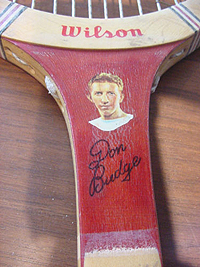
But Vic lacked a sponsor so he was unable to play the first post-war Wimbledon. He went back to college, where he became an All American, and settled for playing the Eastern grasscourt circuit in the states and little more.
Graduating in 1949 at the age of 26 he married his first wife, Dolly who had been a classmate.
"We had quite a honeymoon. In 1950, the USTA sent me, Art Larsen, Doris Hart and Shirley Fry on a goodwill tour to South Africa. I was allowed to bring Dolly along.
The travel was horrendous; DC-4s, low flying, bumpy. But afterwards he was able to play tournaments in Europe for the first time, ending, finally, with his first Wimbledon.
"I thought I might feel intimidated at Wimbledon, but I wasn't. I was just determined to play well. And did. I put out John Bromwich early, and then Eric Sturgess in a tight match."
In the semifinal he lost to Budge Patty, the eventual champion.
In 1951 he was the U.S. singles runner up Frank Sedgman and was named to the Davis Cup team for the first time. For the next seven years the U.S. battled the Australians in the final round.
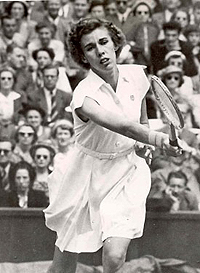
In 1952 England was still having a food shortage, so he took 30 pounds of steak to Wimbledon. Playing with Eric Sturgess, he lost in the doubles final to Frank Sedgman and Ken McGregor and left half of the steak behind for the English players.
Later that year in the U.S. final, Vic reversed the Wimbledon loss. Playing with Merv Rose, they beat Sedgman and McGregor for the title, 8-6 in the fifth.
"That was very gratifying for me, as Sedg did everything I did -- just a little bit better, but not on that day. He turned pro right after that, so he couldn't play us amateurs anymore.
Vic then asked Doris Hart, Sedgman's former partner, to play mixed. She agreed and they won 3 U.S. mixed doubles together, two Wimbledons and two at Roland Garros.
In 1953, he made three Grand Slam finals, including his first and only singles title at Wimbledon. He was also runner up to Ken Rosewall at the French and to Trabert at the U.S.
In 1954 he added a U.S. National singles title and won the doubles with Trabert. In total, Vic and Tony won three other Slams doubles titles, twice at the French and once in Australia.
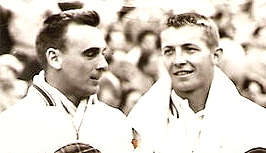
Another big win was the Pacific Southwest Championships at the Los Angeles Tennis Club, unusual in that era since it was played on hard courts.
"This was the only tournament where the players watched the spectators. A lot of Hollywood stars came out to watch. I knew one of them -- Grace Kelly. She was the sister of a classmate of mine back in Philadelphia.
"She invited me to Hollywood to visit her on the set of 'Dial M for Murder'. She was very shy, very beautiful, and introduced me to Ray Milland, Charlton Heston, and others.
"1954 was also the year we finally won the Davis Cup away from Australia! (But they won it back the next year)."
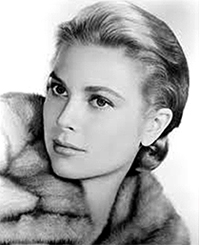
By 1957, Vic was tiring of the tennis grind. "I was 34, and needed to earn a living. I didn't want to be a teaching pro, nor a touring one, so after my final Davis Cup match I went back to Philadelphia, joined Goldman Sachs to learn the investment business and stayed there for the next 17 years.
"I still played tennis, but only when I could get time off to accept invitations to play in nearby places like the Caribbean and Mexico.
"And I kept entering the U.S. championships. As a 'floater', when I was 43, I beat Stan Smith, then only 20, in the first round in 1966. That was fun.
"I believe I also hold the record for the number of years played in the men's singles there -- 28." His birthday happens during the Open, so Vic goes to see old friends like Dick Savitt, Maria Bueno, and Rod Laver.
At 50, he took on a new job -- Director of Tennis at the Greenbrier Resort in West Virginia. "Sam Snead was Director of Golf. We did a lot of sales trips together. It was at Greenbrier that I met my second wife, Toni. I hired her to be one of my teaching pros." They had a daughter, Tori, who is now Membership Chairman at the San Francisco Tennis Club.
Then came what Vic calls "probably the most enjoyable years of my life." The Tennis Grand Masters. That wonderful tour (active from 1974 through 1981) was made up of former champions who were at least 45, but still great players.
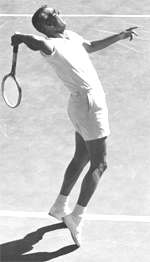
"I was the first player recruited. Frank Sedgman was second, and Tom Brown third.
Bobby Riggs, Bill Talbert, Gardnar Mulloy, Don Budge, Pancho Segura, Pancho Gonzales, Frank Parker, Bobby Riggs, Gene Scott, Sven Davidson, Torben Ulrich all played at some point. We were all comfortable with each other, having played so many tournaments with or against during our youth. We played all over the world, in rotating groups of 8.
"I used to go to the tournament draw, hoping to find I had an easy match. Only to discover it was Sedgman I had to play, and I was the easy match.
When he was 59, Vic wrote a book called "Prime Time Tennis". It's out of print, but still available on the internet. Part memoir it's a guide for middle age players, including how to deal with gamesmanship and injuries.
How did he happen to move to Northern California, and to the little town of Mill Valley? "When I was in New Orleans, I met a lady on vacation who lived out here. She made it sound so great I followed her out. Some timing! I came in October, 1989, just one week after the San Francisco earthquake.
"I ran the pro shop at Harbor Point and was the club's bartender for years. I loved doing that. The club has been very good to me. I have good friends and good health since having my knees replaced in 2005.
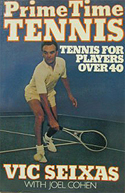
Reflecting on his tennis career, Vic commented on how playing styles have changed.
"In my day, we played all-court tennis. Serve, volley, and rush to the net. We all played that way. Had to. Grass was the important surface and on grass you have to be fast. Get to the ball before it bounces, and know what to do when you get there.
"Today's players are great, but they're boring. Only Federer has an all-round game. Everyone else just hits hard, with a lot of spin, and long baseline rallies. The lenient footfault rule allows players to jump into the court, which gets them a lot more aces than we got. "
Vic also criticizes the 30 second rule between points. "It should be changed. It was supposed to speed up play, but it's done just the opposite.
"When I played, there were no chairs. We just changed sides and kept playing. A match that took us 3 hours in my day would take 6 hours today. "
How do you manage to keep looking so young? I asked him in parting. His reply: "I try to simplify my life. I don't have e-mail, a computer, or a cell phone. I'm too old to learn that stuff.
"I eat very little - a bowl of cereal with a banana and blueberries for breakfast lasts me 'til supper. I take each day as it comes, and I don't worry about anything I can't do anything about."



